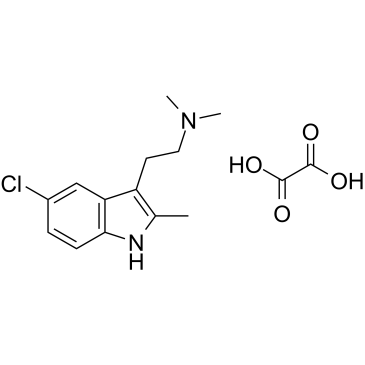1782228-83-4
| Name | ST1936 oxalate |
|---|
| Description | ST1936 oxalate is a selective, nanomolar affinity 5-HT6 receptor agonist with Ki values of 13 nM, 168 nM and 245 nM for human 5-HT6, 5-HT7 and 5-HT2B receptors, respectively. ST1936 oxalate also shows moderate affinity (Ki of 300 nM) for human α2 adrenergic receptor[1]. |
|---|---|
| Related Catalog | |
| Target |
5-HT6 Receptor:13 nM (Ki) Human 5-HT7 Receptor:168 nM (Ki) 5-HT2B Receptor:245 nM (Ki) |
| In Vitro | ST1936 appears to be relatively selective for 5-HT6 receptors, although it has shown affinity also for 5-HT2B, 5-HT1A, 5-HT7 receptor and α-adrenergic receptors when tested in a broad crossreactivity panel that comprised G-protein-coupled receptors, ion channel binding sites, enzymes, and transporters[1]. |
| In Vivo | In-vivo electrophysiological studies are performed to investigate the physiological role of 5-HT6 receptors in the control of the function of the substantia nigra pars compacta (SNc) and ventral tegmental area (VTA). Extracellular single-unit recordings are performed from putative dopamine-containing neurons in the SNc and VTA of anesthetised rats (Male Sprague-Dawley rats). In the SNc, acute systemic administration of ST1936 (Intravenous injection; 50–1600 µg/kg for the SNc; 50–400 µg/kg for the VTA) has no effects on basal firing activity of these dopamine neurons; however, in the VTA, ST1936 induces either dose-related increases (45% of cells) or decreases in basal activity of these dopaminergic neurons[1]. |
| References |
| Molecular Formula | C15H19ClN2O4 |
|---|---|
| Molecular Weight | 326.78 |
